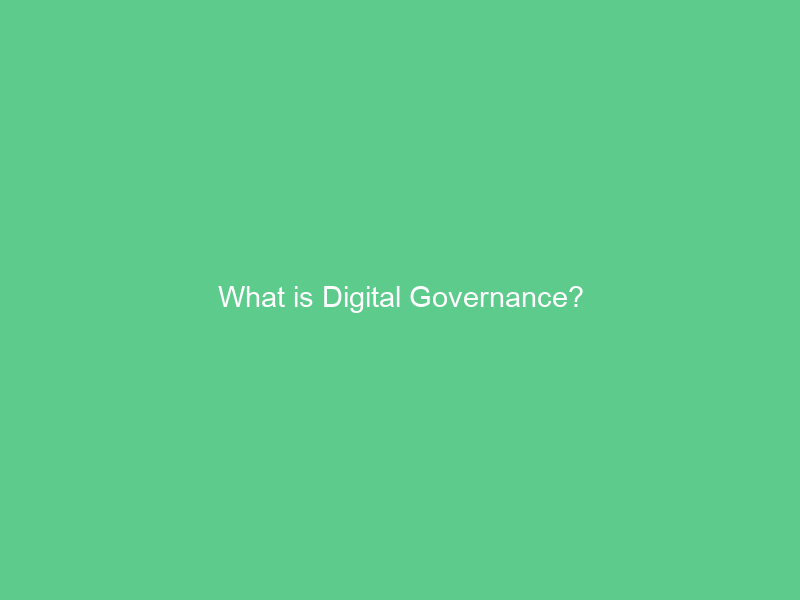Digital governance is a formal framework that establishes accountability, roles, and decision-making processes for your organization’s digital products and services. It helps organizations conduct digital activities ethically while protecting from legal issues or cyber attacks as well as adapting quickly in response to change.
Content, design, technical infrastructure, security, funding and product management all play a part in successful project and program administration.
Creating a Digital Strategy
Digital governance establishes who is accountable for running and overseeing an agency’s website and digital services, from content creation, design, technical infrastructure and security through funding allocation, product, project and program management, product lifecycle management to public trust building. A strong governance structure can increase organizational performance as well as enhance citizen outcomes.
Crafting digital transformation policies and practices that align with sustainability goals is crucial for building consensus, expanding team capacity and saving money through unnecessary products or services being eliminated. Aligning technology requirements with sustainability goals as well as screening third-party tools which don’t support them are also important steps.
An ethical digital strategy could include adopting an online board management system such as BoardEffect that encourages collaboration and communication while protecting sensitive information from outside sources and cyber attacks, rather than using multiple email accounts and file-sharing apps which put organizations at risk of cyber attacks. By doing this, boards will reduce time spent managing multiple tools at once.
Defining Digital Accountability
Digital governance involves developing a framework for accountability in digital environments, and understanding its implementation in this medium. This involves assigning specific roles and accountabilities to individuals as well as setting standards, procedures, and clarifying responsibilities – prioritizing ethical digital practices while protecting against legal issues or cyber attacks – while helping companies remain agile against disruption.
Digital accountability also involves exploring how non-human actors (algorithms and infrastructure) affect digital processes and policies. This analysis can include feminist perspectives that tackle algorithmic bias and online harassment; critical race theory examines digital harms’ disproportionate effect on marginalized communities.
Digital governance involves streamlining service delivery mechanisms and providing citizens with easy access to digital information. This may involve engaging citizens in policymaking via citizen engagement platforms such as e-petitions and participatory budgeting initiatives, and more transparent and accessible public processes; as well as streamlining internal processes to produce more responsive and effective government services.
Creating a Digital Framework
An effective digital governance strategy is a key element of effective board oversight of any organisation. Boards should dedicate sufficient time and attention to understand how digital governance fits within their broader governance framework and aims, rather than viewing it solely as something left to technical specialists.
Create a cross-functional governance team to develop your digital governance strategy, comprising stakeholders from different areas of your organization such as marketing, grantmaking, volunteers and staff. Make sure this committee includes representatives from each of these groups in order to bring diverse perspectives into consideration and ensure equity throughout.
This helps avoid silos where teams may duplicate efforts or miss key pieces of the puzzle, increasing risk to the organisation. Furthermore, collaboration and transparency ensure digital policies and standards align with wider organisational goals; additionally a good digital governance framework offers scalability and flexibility so it can adapt as the organisation changes or grows.
Creating a Digital Culture
Digital culture refers to an organization’s collection of practices which reflect employees’ behaviors, mindsets and values in an adaptable manner in a quickly shifting business environment. It serves as a way for governing bodies to stay ahead of rapidly developing environments.
Leadership must remain open to new ideas and encourage employees to think creatively in order to foster an innovative digital culture. Furthermore, they should invest in workshops and technologies which enable staff members to learn new skills collaboratively.
Digital cultures also entail making decisions quickly and with agility. If an organization’s decision-making system is bogged down by bureaucracy and red tape, adaptability will become difficult and iterative changes won’t happen as easily. Finally, organizations must align digital governance with their missions and strategic plans; for example marketers should incorporate sustainability principles into their tech stack, moving away from tools that generate biased or unethical content, to ensure that marketing generates value for customers and communities alike.

